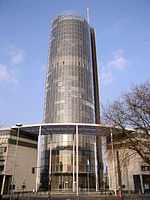
The Advanced Gas-cooled Reactor (AGR) is a type of nuclear reactor designed and operated in the United Kingdom. These are the second generation of British gas-cooled reactors, using graphite as the neutron moderator and carbon dioxide as coolant. They have been the backbone of the UK's nuclear power generation fleet since the 1980s.

Dresden Generating Station is the first privately financed nuclear power plant built in the United States. Dresden 1 was activated in 1960 and retired in 1978. Operating since 1970 are Dresden units 2 and 3, two General Electric BWR-3 boiling water reactors. Dresden Station is located on a 953-acre (386 ha) site in Grundy County, Illinois, at the head of the Illinois River, near the city of Morris. It is immediately northeast of the Morris Operation—the only de facto high-level radioactive waste storage site in the United States. It serves Chicago and the northern quarter of the state of Illinois, capable of producing 867 megawatts of electricity from each of its two reactors, enough to power over one million average American homes.
RWE AG is a German multinational energy company headquartered in Essen. It generates and trades electricity in Asia-Pacific, Europe and the United States. The company is the world's number two in offshore wind power and Europe's third largest company in renewable energy. In the 2020 Forbes Global 2000, RWE Group was ranked as the 297th-largest public company in the world.
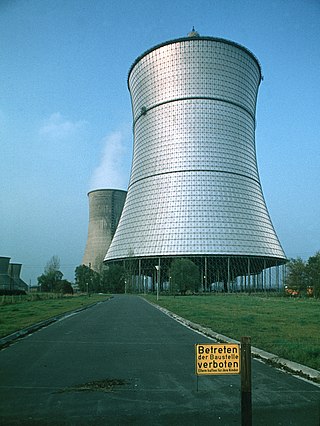
The THTR-300 was a thorium cycle high-temperature nuclear reactor rated at 300 MW electric (THTR-300) in Hamm-Uentrop, Germany. It started operating in 1983, synchronized with the grid in 1985, operated at full power in February 1987 and was shut down September 1, 1989. The THTR-300 served as a prototype high-temperature reactor (HTR) to use the TRISO pebble fuel produced by the AVR, an experimental pebble bed operated by VEW. The THTR-300 cost €2.05 billion and was predicted to cost an additional €425 million through December 2009 in decommissioning and other associated costs. The German state of North Rhine Westphalia, Federal Republic of Germany, and Hochtemperatur-Kernkraftwerk GmbH (HKG) financed the THTR-300’s construction.

Niederaussem Power Station is a lignite-fired power station in the Bergheim Niederaussem/Rhein Erft circle, owned by RWE. It consists of nine units, which were built between 1963 and 2003. It is the second-largest lignite coal power plant in operation in Germany, with total output capacity of 3,864 MW and a net capacity of 3,396 MW. The plant is estimated to have been one of the ten most carbon polluting coal-fired power plants in the world in 2018, at 27.2 million tons of carbon dioxide, and its emissions intensity is estimated to be 45.1% higher relative to the average for all fossil-fueled plants in Germany. According to the study Dirty Thirty, issued in 2007 by the WWF, Niederaussem Power Station is the second worst power station in Europe in terms of mercury emissions due to the use of lignite.
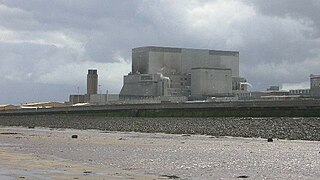
Hinkley Point B nuclear power station is a nuclear power station near Bridgwater, Somerset, on the Bristol Channel coast of south west England. It was the first commercial Advanced Gas Cooled reactor to generate power to the National Grid in 1976 and shares its design with sister station Hunterston B nuclear power station. It ceased operations permanently on 1 August 2022.

Nuclear power in Germany accounted for 13.3% of German electricity supply in 2021, generated by six power plants, of which three were switched off at the end of 2021, the other three due to cease operation at the end of 2022 according to the complete nuclear phase-out plan of 2011. However, in early 2022 this plan was called into question once more in light of the 2022 Russian invasion of Ukraine which threatens Germany's supply of natural gas. There have been calls to either delay the shutdown of the remaining three reactors or to restart operation in those reactors that were shut down in late 2021.

Oldbury nuclear power station is a Magnox nuclear power station undergoing decommissioning. It is located on the south bank of the River Severn close to the village of Oldbury-on-Severn in South Gloucestershire, England. The ongoing decommissioning process is managed by Magnox Ltd, a subsidiary of the Nuclear Decommissioning Authority (NDA).

Krümmel Nuclear Power Plant is a German nuclear power plant in Geesthacht, Schleswig-Holstein, near Hamburg. It was taken into operation in 1983 and is owned 50% by Vattenfall via Vattenfall Europe Nuclear Energy GmbH and 50% by E.ON, and operated by the Swedish Vattenfall. Its gross power production is 1,401 MW, using a boiling water reactor.

The Grafenrheinfeld nuclear power plant is a now-offline electricity-generating facility near Grafenrheinfeld, south of Schweinfurt at the river Main. The plant operated from 1981 to June 28, 2015, when it was taken offline as part of the phase out policy for nuclear power in Germany.
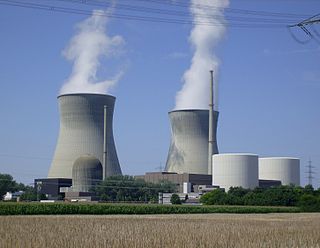
The Gundremmingen Nuclear Power Plant is a nuclear power station in Germany. It is located in Gundremmingen, district of Günzburg, Bavaria. It is operated by Kernkraftwerk Gundremmingen GmbH, a joint operation of RWE Power AG (75%) and PreussenElektra (25%). Unit B was shut down at the end of 2017. Unit C, the last boiling water reactor in Germany, was shut down on New Year's Eve 2021, as part of the German nuclear phase out. However, Gundremmingen unit C as well as the other two German nuclear reactors shut down that day remain capable of restarting operations as of March 2022. In November 1975, Unit A was the site of the first fatal accident in a nuclear power plant and subsequently of a major incident resulting in a total loss in 1977.

Balakovo nuclear power station is located in the city of Balakovo, Saratov Oblast, Russia, about 900 kilometres (560 mi) south-east of Moscow. It consists of four operational reactors; a fifth unit is still under construction. Owner and operator of the nuclear power station is Rosenergoatom.

The Beznau nuclear power plant is a nuclear power plant of the Swiss energy utility Axpo, located in the municipality Döttingen, Canton of Aargau, Switzerland, on an artificial island in the Aar river. The plant has been operating since September 1969.
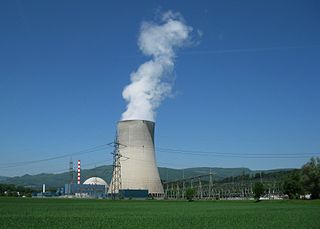
The Gösgen Nuclear Power Plant is located in the Däniken municipality on a loop of the Aar river. It is operated by the ad hoc society Kernkraftwerk Gösgen-Däniken AG.

The Leibstadt Nuclear Power Plant is located near Leibstadt, canton of Aargau, Switzerland, on the Rhine River and close to the border to Germany. Commissioned in 1984, it is the youngest and most powerful of the country's four operating reactors.

The Mühleberg Nuclear Power Plant is a formerly operational nuclear power plant in the Mühleberg municipality in the Canton of Berne, Switzerland. Operated by BKW FMB Energie AG, the plant generated power from 6 November 1972 until 20 December 2019. Nuclear decommissioning of the plant began January 2020 and is currently forecasted to be completed by 2034.

Greifswald nuclear power station, also known as Lubmin nuclear power station, was the largest nuclear power station in East Germany before closure shortly after the German reunification. The plants were of the VVER-440/V-230 type, which was the second generation of Soviet-designed plants. The plant is in Lubmin near Greifswald, in the state of Mecklenburg-Vorpommern.

Rheinsberg Nuclear Power Station was the second nuclear reactor in East Germany after the Rossendorf Research Reactor, and the first nuclear power reactor in East Germany. It was built close to the city of Rheinsberg on the Stechlinsee. The power station was one of the first generation of demonstration power reactors.

The nuclear power station Mülheim-Kärlich lies on the Rhine, about 10 km northwest from Koblenz, close to the town Mülheim-Kärlich in Germany. The operating company was Société Luxembourgeoise de Centrales Nucléaires, a daughter company of RWE. It was the only nuclear power plant in the Rhineland-Palatinate after it was finished in 1986, however, due to problems with the building permit it only operated for 3 years and was taken offline in 1988. Subsequent attempts to bring the plant online continued until 1998 when the supreme court ruled for it to never be restarted.

The Fessenheim Nuclear Power Plant is located in the Fessenheim commune in the Haut-Rhin department in Grand Est in north-eastern France, 15 km (9.3 mi) north east of the Mulhouse urban area, within 1.5 km (0.93 mi) of the border with Germany, and approximately 40 km (25 mi) from Switzerland. Unit 1 was closed in February 2020 and unit 2 on 29 June 2020.

























